 Kalliope’s
Comments
(group member since Aug 28, 2018)
Kalliope’s
Comments
(group member since Aug 28, 2018)
Kalliope’s
comments
from the Ovid's Metamorphoses and Further Metamorphoses group.
Showing 81-100 of 610
 I found more images on Achelous. I like this one because it shows him when in the guise of the bull, he is losing his horn...
I found more images on Achelous. I like this one because it shows him when in the guise of the bull, he is losing his horn...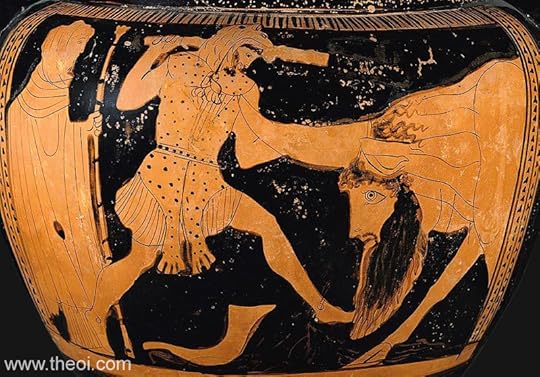
Another one focusing on Achelous as bull:
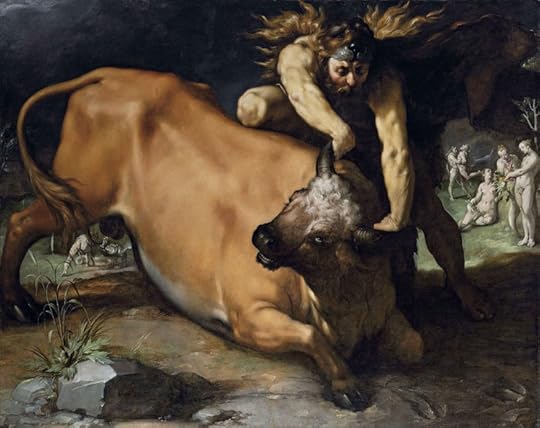
Cornelis van Haarlem. 1590
Typical of the Mannerists, he plays with the shifts in scales to suggest both distance and emphasise the aspects in the story that interest him.
 Peter wrote: "Not related to Ovid, but still worth sharing, I hope. A 70 m pyramid with an 8 m statue of Hercules is towering over the German city of Kassel. It was constructed 300 years ago together with a lavi..."
Peter wrote: "Not related to Ovid, but still worth sharing, I hope. A 70 m pyramid with an 8 m statue of Hercules is towering over the German city of Kassel. It was constructed 300 years ago together with a lavi..."Peter, I have just returned from Naples, and there, in the Archaeological Museum they have the Farnese Hercules on which your German version seems to be based.
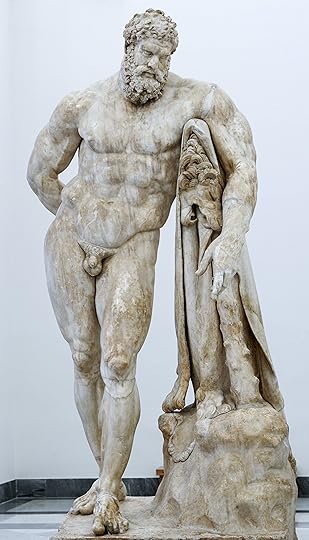
 Hello everyone and my most sincere apologies. I dropped out because things in my life just got out of hand - they metamorphosed in a hydra with too many heads. I was sorry to have to put Ovid on the side.
Hello everyone and my most sincere apologies. I dropped out because things in my life just got out of hand - they metamorphosed in a hydra with too many heads. I was sorry to have to put Ovid on the side.I have just reread the first section of Book IX, the section of Hercules, and hope to finish it by the weekend. I may catch up with you in a later book.
 RC, I have now arrived at the section where Ovid associates the two kinds of Labours - the Herculean and that of childbirth.
RC, I have now arrived at the section where Ovid associates the two kinds of Labours - the Herculean and that of childbirth. I thought I had missed it, but I just had not read enough.
Excellent.
 This book is an interesting one for the 'connections' (or lack of thereof) between the various stories and myths.
This book is an interesting one for the 'connections' (or lack of thereof) between the various stories and myths.It is not the first time that two books are bridged connecting the end and the beginning - like cliff hangers.
And then, as the notes in my edition point out, the long Hercules episode begins with Achelous speaking in first person but then it shifts onto an omniscient narrator for the rest of Hercules and we forget about Achelous.
I certainly have to read this section again.
 Roman Clodia wrote: "Excellent - I had no idea that the Hapsburgs associated their lineage with Hercules. Presumably they focused on the 'heroic' side of his legend rather than the episode where he goes mad and kills h..."
Roman Clodia wrote: "Excellent - I had no idea that the Hapsburgs associated their lineage with Hercules. Presumably they focused on the 'heroic' side of his legend rather than the episode where he goes mad and kills h..."Haha... yes... The phrase 'Non Plus Ultra' is still part of the Spanish coat of arms... It comes from Hercules' Pillars... and the non terrae plus ultra.
 Hercules is such a pervasive character... Many noble and royal dynasties like to associate themselves with him. One of them was the Spanish Habsburg branch. For the Hall of the Kingdoms in the now gone Palace of Buen Retiro (we have the park, luckily),there was a series of paintings on Hercules labours. As Ovid 'stands in profile' vis à vis the Labours I was not going to post much on it. I will just include one of them. These paintings hung over the doors and were seen from beneath.
Hercules is such a pervasive character... Many noble and royal dynasties like to associate themselves with him. One of them was the Spanish Habsburg branch. For the Hall of the Kingdoms in the now gone Palace of Buen Retiro (we have the park, luckily),there was a series of paintings on Hercules labours. As Ovid 'stands in profile' vis à vis the Labours I was not going to post much on it. I will just include one of them. These paintings hung over the doors and were seen from beneath.Francisco de Zurbarán. Hercules separates the Mounts Calpe and Abyla. 1630. Prado.
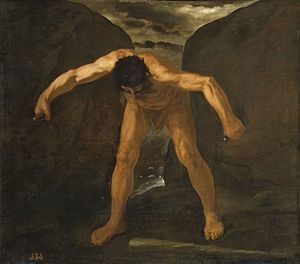
 Roman Clodia wrote: "... and looking forward to the reverse metamorphosis of Pygmalion's statue ;)"
Roman Clodia wrote: "... and looking forward to the reverse metamorphosis of Pygmalion's statue ;)"Ah, yes, of course... It will be welcomed, after so many figures turning into stone... One of my favourite scenes was the turning of Ino's followers into a gallery of statues.
 I am jumping ahead and posting here before our reading has begun, but reading the London National Gallery Guidebook I encounter this very interesting portrait.
I am jumping ahead and posting here before our reading has begun, but reading the London National Gallery Guidebook I encounter this very interesting portrait.Pierre Mignard. The Marquise de Seignelay and Two of her Sons. 1691. London National Gallery.

The Marquise (widow of Jean-Baptiste-Antoine Robert de Seignelay, Minister of the Navy under Louis XIV) asked the painter to depict her as the sea-nymph Thetis....
The book attributes to Neil MacGregor the idea that the Ovid text is the key to the portrait. Like Thetis, Mll de Matignon, of old Norman nobility, had been married off against her will to a social inferior: Colbert. Her husband's father and the great Minister of the King, was the son of a draper. The goddess's husband, Peleus, had to rape Thetis to 'get on her the great Achilles'. the hero's mother, goddess of the sea, was ambitious for her son and by descending into the fiery crater of Etna, the volcano seen here smoking in the background, obtained for him armour made by Vulcan.
We have to remember that her husband was the Minister for the Navy...!!!
 I am reading through the London National Gallery Guide, which is wonderful.
I am reading through the London National Gallery Guide, which is wonderful.Anyway, I have come upon this painting by:
Luca Giordano. Perseus turning Phineas and his Followers to Stone. 1680. London Nationnal Gallery.
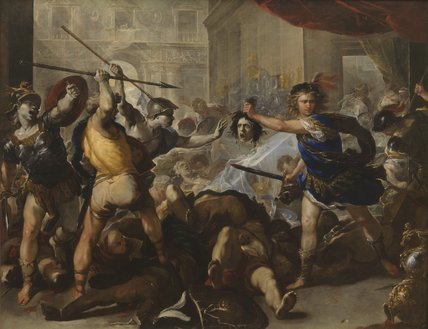
What is striking is is the very successful way in which Giordano shows Phineas in the process of turning grey as a stone.
And this makes me think of the ongoing rivalry that went on between painters and sculptors, vying with each other for the 'truest' and most effective art... Here a painter shows us a figure that is losing its life by turning from a living being to a dead sculpture...Haha...
 Elena wrote: "Kalliope wrote: "Yesterday I went to watch 'The Russian Ark' which was filmed in the Hermitage. Some of the paintings are shown, and one that took pride of place was Rembrandt's Danäe. Kalliope, it..."
Elena wrote: "Kalliope wrote: "Yesterday I went to watch 'The Russian Ark' which was filmed in the Hermitage. Some of the paintings are shown, and one that took pride of place was Rembrandt's Danäe. Kalliope, it..."Thank you, Elena.. yes, it is an extraordinary film. I am sorry I had not seen your message until now, when I have come back to this Thread to post on another painting I found.
 Elena wrote: "I'm interested in what is not in a text. While there are important scenes of a storytelling and singing, Emily Wilson says there is not any mention at all in the Odyssey of reading from a scroll or..."
Elena wrote: "I'm interested in what is not in a text. While there are important scenes of a storytelling and singing, Emily Wilson says there is not any mention at all in the Odyssey of reading from a scroll or..."Thank you for this, Elena... I had not noticed but you are right... peculiar.
 Peter wrote: "Not related to Ovid, but still worth sharing, I hope. A 70 m pyramid with an 8 m statue of Hercules is towering over the German city of Kassel. It was constructed 300 years ago together with a lavi..."
Peter wrote: "Not related to Ovid, but still worth sharing, I hope. A 70 m pyramid with an 8 m statue of Hercules is towering over the German city of Kassel. It was constructed 300 years ago together with a lavi..."Interesting history snippet, Peter. Thank you again.
 Peter wrote: "
Peter wrote: "and this is where he ended up (from Urania's Mirror, 1824)
"
Oh, this is perfect. Thank you, Peter.
 And now an image with the fight AND the cornucopia...
And now an image with the fight AND the cornucopia...Noel Coypel. Musée des Beaux-Arts in Lille. Around 1660.
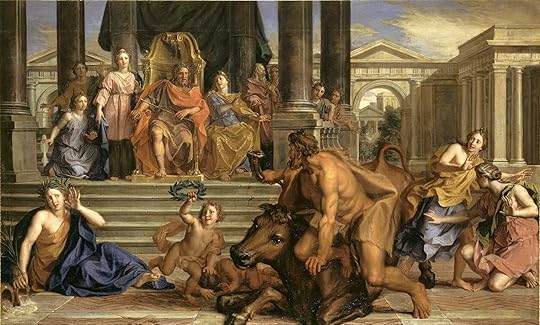
This French painter was in the circle of the King Louis XIV, painting several pieces (walls and ceilings) in Versailles.
It looks like he did the whole Hercules series.. I will look for the rest.
The Acheolus has this other version:
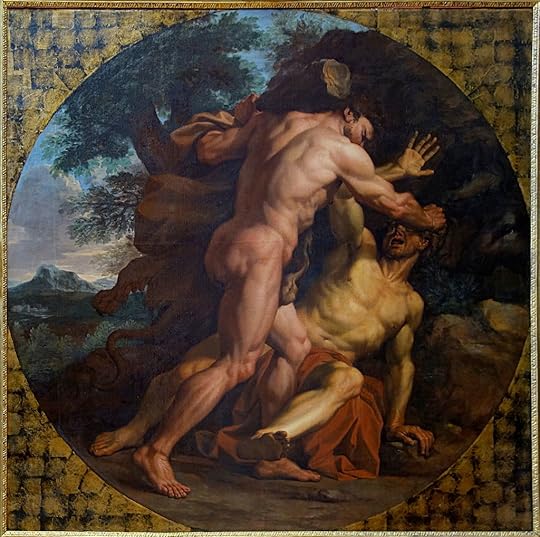
 Here several views of a very interesting statuette.
Here several views of a very interesting statuette. Unidentified sculptor - Austrian. Ca 1650-75. Hercules & Achelous. British Museum.



 Not as elaborate as Medea's but we get a bit of self-analysis in Deianira...
Not as elaborate as Medea's but we get a bit of self-analysis in Deianira... Sad that she has been deluded and the course of action she choses is not to her interest.
 I loved the story of the origin of the cornucopia... I had no idea.. I will look for more pertinent images, but one jump back at me in my mind, since I saw it in an exhibition a few months ago. The painting is in the Prado but usually not exhibited.
I loved the story of the origin of the cornucopia... I had no idea.. I will look for more pertinent images, but one jump back at me in my mind, since I saw it in an exhibition a few months ago. The painting is in the Prado but usually not exhibited.Of course it had to be Rubens again.
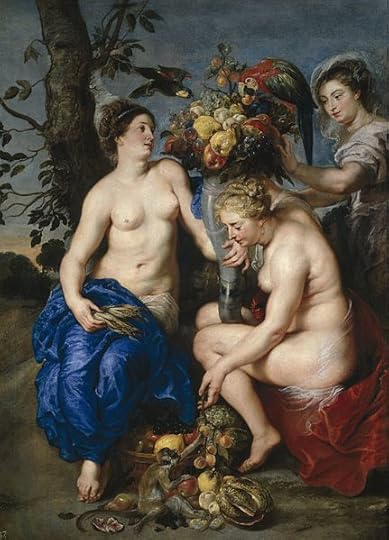
Rubens & Snyders. Ceres and two Nymphs. Before 1628. Prado.
Rubens brought the painting with him when he came to Madrid in his second trip in 1628.
The actual cornucopia may be by Snyders, while the females are by Rubens.
 Roman Clodia wrote: "I especially like the Ovidian wit that links Hercules' well-known Labours with the labour of women in childbirth.
Roman Clodia wrote: "I especially like the Ovidian wit that links Hercules' well-known Labours with the labour of women in childbirth...."
RC, thank you for pointing this out... My first read is usually very fast, to get a sense of the placing of characters etc.. I will look for this in my next read.


